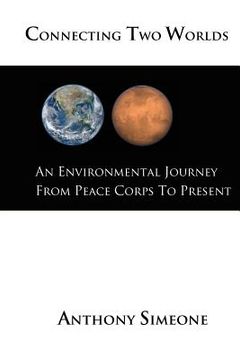Share
Connecting Two Worlds: An Environmental Journey from Peace Corps to Present (in English)
Anthony T. Simeone
(Author)
·
Peace Corps Writers
· Paperback
Connecting Two Worlds: An Environmental Journey from Peace Corps to Present (in English) - Simeone, Anthony T.
$ 15.96
$ 19.95
You save: $ 3.99
Choose the list to add your product or create one New List
✓ Product added successfully to the Wishlist.
Go to My WishlistsIt will be shipped from our warehouse between
Monday, June 17 and
Tuesday, June 18.
You will receive it anywhere in United States between 1 and 3 business days after shipment.
Synopsis "Connecting Two Worlds: An Environmental Journey from Peace Corps to Present (in English)"
He approached me with some trepidation but also with a sense of urgency in his voice. He asked to close the door of my mud-brick house so that he could speak to me in private and was clearly nervous about the issue he wanted to discuss. With some hesitancy, he cautiously proceeded to ask his troubling question. "Was it possible for his friend to dig a well so deep that he would fall through the other side of the earth?" He waited for my response. Early in my two years as a Peace Corps Volunteer, I thought such questions were naïve and amusing. I soon realized that "real world" meant different things in different cultures. I had many interesting conversations and experiences and have captured a variety of them in Connecting Two Worlds. I lived in the Sahel region of French West Africa. This is a belt of hot, arid land that stretches a from Senegal in the west to the Sudan in the east forming a seamless boundary with the Sahara Desert. The encounters and connections I made have remained vividly alive for me forty years later as I piece together my experiences with the people and the environment then with our world now. Today, as we begin to experience greater uncertainty in ecosystem health and sustainability, as we begin to experience "peak" everything from oil to water, I have suddenly begun to see the convergence of two worlds that had once seemed so very far apart. Throughout Earth's history, nature has controlled the processes that manage species diversity, evolution and extinction with remarkable efficiency. These natural processes began to change with the onset of the Industrial Revolution and in the 200 years since. Resource depletion continues to worsen as growing consumption demands and nature's natural balance are disrupted by rapid population expansion. The world of nature has come under the assault of the world of humans. I have used the contrasting images of Earth and Mars to state the obvious. Visually, our planets are strikingly different. Some of the differences presented in Connecting Two Worlds may also be very obvious. The stories used from my life in sub-Saharan Africa show that what was strange and different to me so many years ago is not so obviously strange today. We may smile at the thought of someone thinking they could dig a well so deep as to be in danger of falling through the planet. We can no longer smile at the thought that Earth's environment is now at a precarious tipping point. When we were merely one billion inhabitants 200 years ago, we had abundant resources. Today, as our global population passes rapidly beyond seven billion, we are experiencing an array of challenges that is the direct result of our success as a species. Throughout the Sahel and in most other developing countries, subsistence determines what nourishment will be provided on any given day. There are no guarantees that tomorrow will be better than today. It will probably be worse. The drought conditions I experienced in Africa have arrived, unannounced, in Australia, in Texas and high in the Peruvian Andes. The factors that necessitated migration from the Sahara to the Sahel to urban areas to find a better and safer home are now encouraging illegal and dangerous cross-border migration along the entire US/Mexican border where the dangers are just as high-risk. The climate change that is contributing to rising ocean levels is no longer just a problem for Southeast Asia but is striking the heart of the Eastern United States. New islands are actively being formed in the Pacific Ocean - not just from volcanic eruptions deep below the ocean surface but from the millions of pounds of discarded plastic that swirl endlessly throughout the numerous ocean gyres. The planet must now awaken to a new urgency of sustainability. Sustainable living may soon become our final strategy for getting things right. "The difficulty lies not so much in developing new ideas as in escaping from old ones." John Maynard Keynes
- 0% (0)
- 0% (0)
- 0% (0)
- 0% (0)
- 0% (0)
All books in our catalog are Original.
The book is written in English.
The binding of this edition is Paperback.
✓ Producto agregado correctamente al carro, Ir a Pagar.

